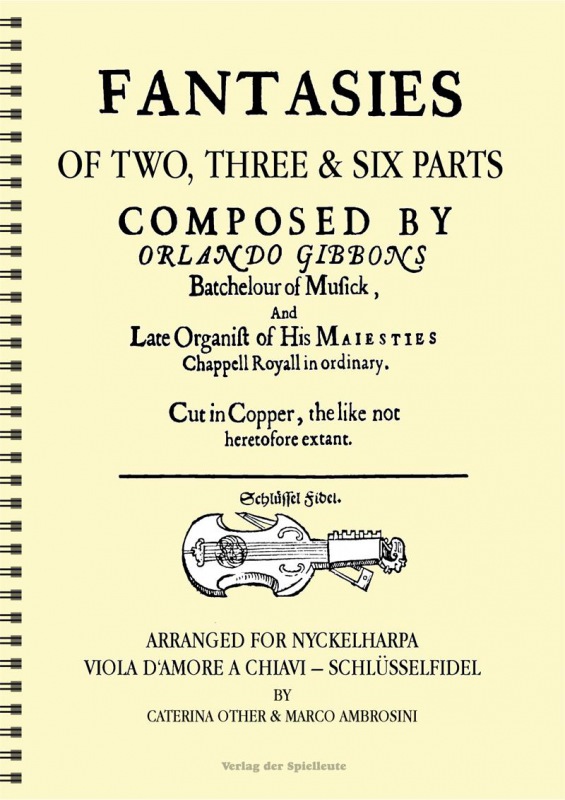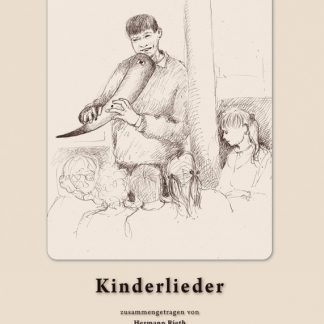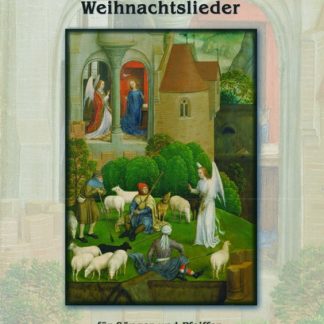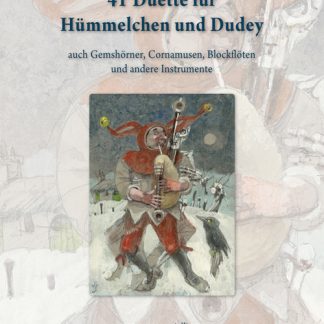Description
FANTASIES of TWO, THREE & SIX PARTS
Arranged for Nyckelharpa by Caterina Other & Marco Ambrosini
Gibbons was born in 1583 (probably in December) and baptized on Christmas Day in Oxford, where his father William Gibbons worked as a waiter. Between 1596 and 1598 he sang in the choir of King’s College, Cambridge, where his brother Edward Gibbons (1568-1650), eldest of William Gibbons’ four sons, directed the choir. The second brother Ellis Gibbons (1573-1603) was also a promising composer, but died young. Orlando began studies at the University in 1598 and earned a Bachelor of Music degree in 1606. That same year he married Elizabeth Patten, daughter of a yeoman of the vestry, and they had seven children (Gibbons himself was the seventh of ten children).
King James I appointed him a gentleman of the Chapel Royal, where he served as organist from about 1615 until his death. In 1623 he became senior organist of the Chapel Royal, with Thomas Tomkins as junior organist. He also served as organist in the secret chamber of the court of Prince Charles (later King Charles I) and also in Westminster Abbey.
He died of apoplexy in Canterbury at the age of 41 and was buried in Canterbury Cathedral. His death was a shock to his peers and led to an autopsy, although the cause of death attracted less attention than the haste with which he was buried and that his body was not returned to London. His wife, Elizabeth, died a little more than a year later, in her mid-30s, leaving Orlando’s oldest brother, Edward, to care for the orphaned siblings. Of these children, only the oldest son, Christopher Gibbons, was to become a musician.
His work
Gibbons, one of the most versatile English composers of his time, wrote a large number of works for keyboard instruments, some thirty fantasies for viols, a number of madrigals (the best known being “The Silver Swan”), and many popular verse anthems, all for English texts. Perhaps his best-known verse anthem is “This Is the Record of John,” which sets an Advent text for solo countertenor or tenor, alternating with full chorus.
He also produced two major settings of Evensong, the Short Service and the Second Service, an extended composition combining verse and whole sections. Gibbons’ full hymns include the expressive “O Lord, in Thy Wrath” and the Ascension Hymn “O Clap Thy Hands Together” for eight voices. He contributed six pieces to the first printed collection of keyboard music in England, Parthenia (to which he was by far the youngest of the three contributors), published about 1611. Gibbons’ surviving keyboard edition includes about 45 pieces.
Polyphonic fantasy and dance forms are the best represented genres. Gibbons’ writing features a command for three- and four-part counterpoint. Most fantasies are complex, multi-part pieces that treat several themes imitatively. Gibbons’ approach to melody, both in his fantasies and in his dances, is characterized by an extensive development of simple musical ideas, as in Pavane in D minor and “Lord Salisbury’s Pavan and Galliard.”
Why should the works of Orlando Gibbons be performed on the nyckelharpa?
Michael Praetorius wrote in his book “Syntagma Musicum, Tomus Secundus” about an English instrument with sympathetic strings, the viola bastarda: “Now in England something strange has been invented about it / that among the right common six strings / yet eight other stems and turned brass strings / lie on a brass bridge (like the ones used on the pandorren) / which must be tuned with the upper strings in the same way and in a pure way. Now, when the topmost of the other instruments is stirred with the finger or bow, the lowest brass or steel instruments resonate per consensus at the same time with tremors and tremolos, and the sweetness of the harmony is increased and expanded by this.
In recent years we have noticed a great interest in early music performances by nyckelharpa players! Our beloved instrument, not only as a more or less correct historical reconstruction, e.g. the so-called “Siena keyed vielle” or the “Moraharpa”, but also in its modern 4-row “continental” version, and the sound of which perfectly fits the music from the late Middle Ages to the Baroque. Gibbons’ consort works have an exciting sound when played by two or more Nyckelharpor.
Some time ago we started arranging this music for our students. We spent a long time rehearsing and performing the fantasies, and now we have decided to spread the word and share our work in the form of this publication.
This edition of the fantasies is specially designed for 4-row nyckelharpa, tuned in fifths. It should be noted that in almost all cases the upper voices are also suitable for 3-row instruments in traditional and fifth tuning.
English language texts
English:
FANTASIES of TWO, THREE & SIX PARTS
Arranged for Nyckelharpa by Caterina Other & Marco Ambrosini
Gibbons was born in 1583 (most likely in December) and baptized on Christmas Day at Oxford, where his father William Gibbons was working as a wait. Between 1596 and 1598 he sang in the Choir of King’s College, Cambridge, where his brother Edward Gibbons (1568-1650), eldest of the four sons of William Gibbons, was master of the choristers. The second brother Ellis Gibbons (1573-1603) was also a promising composer, but died young. Orlando entered the university as a sizar in 1598 and achieved the degree of Bachelor of Music in 1606. That same year he married Elizabeth Patten, daughter of a Yeoman of the Vestry, and they went on to have seven children (Gibbons himself was the seventh of 10 children).
King James I appointed him a Gentleman of the Chapel Royal, where he served as an organist from at least 1615 until his death. In 1623 he became senior organist at the Chapel Royal, with Thomas Tomkins as junior organist. He also held positions as keyboard player in the privy chamber of the court of Prince Charles (later King Charles I), and organist at Westminster Abbey.
He died at age 41 in Canterbury of apoplexy, and was buried in Canterbury Cathedral. His death was a shock to his peers and brought about a post-mortem, though the cause of death aroused less comment than the haste of his burial and his body not being returned to London. His wife, Elizabeth, died a little over a year later, in her mid-30s, leaving Orlando’s eldest brother, Edward, to care for the orphaned children. Of these children only the eldest son, Christopher Gibbons, was to become a musician.
His Work
One of the most versatile English composers of his time, Gibbons wrote a large number of keyboard works, around thirty fantasias for viols, a number of madrigals (the best-known being “The Silver Swan”), and many popular verse anthems, all to English texts. Perhaps his most well-known verse anthem is “This Is the Record of John”, which sets an Advent text for solo countertenor or tenor, alternating with full chorus.
He also produced two major settings of Evensong, the Short Service and the Second Service, an extended composition combining verse and full sections. Gibbons’s full anthems include the expressive “O Lord, in thy wrath,” and the Ascension Day anthem “O clap your hands together” for eight voices. He contributed six pieces to the first printed collection of keyboard music in England, Parthenia (to which he was by far the youngest of the three contributors), publish in about 1611. Gibbons’s surviving keyboard output comprises some 45 pieces.
The polyphonic fantasia and dance forms are the best represented genres. Gibbons’s writing exhibits a command of three- and four-part counterpoint. Most of the fantasias are complex, multi-sectional pieces, treating multiple subjects imitatively. Gibbons’s approach to melody, in both his fantasias and his dances, features extensive development of simple musical ideas, as for example in Pavane in D minor and “Lord Salisbury’s Pavan and Galliard”.
Why should Orlando Gibbons’s works be performed on the nyckelharpa?
In his book “Syntagma Musicum, Tomus Secundus” Michael Praetorius wrote about an English instrument with sympathetic strings, the viola bastarda: “Jetzo ist in Engelland noch etwas sonderbares darzu erfunden / dass vnter den rechten gemeininen sechs Säitten / noch acht andere Stälene vnd gedrehte Messings=Säitten / vff eim Messingen Steige (gleich die vff den Pandorren gebraucht werden) liegen / welche mit den Obersten gleich vnd gar rein eingesimmet werden müssen. Now, if one of the topmost of the other saddles is stirred with the finger or bow, the lowest brass or steel saddle resonates per consensum at the same time with trembling and tremulousness, so that the sweetness of the harmony is increased and expanded by this, as it were.”
In the last few years, we have noticed great interest in performances of Early Music by nyckelharpa players! Our beloved instrument, not only as a more or less correct historical reconstruction, e.g. of the so-called “Siena keyed vielle” or the “Moraharpa”, but also in its modern 4-row “continental” version, and its sound suit the music from the Late Middle Ages to Baroque perfectly. Gibbons’s consort works have an exciting sound when performed by two or more nyckelharpor.
Some time ago, we started arranging this music for our students. Having spent a long time rehearsing and performing the Fantasies, we have finally decided to spread the word and share our work in the form of this publication.
This edition of the Fantasies is designed especially for 4-row nyckelharpa, tuned in fifths. Note that in nearly all cases, the upper voices are also suitable for 3-row instruments in both the traditional and fifth tunings.
The book is written in English language.
Order no: 13-3
ISBN: 978-3-943060-13-3
Format: DIN A4
Number of pages: 46 pages
Cover: Softcover with Wire-O






Reviews
There are no reviews yet.